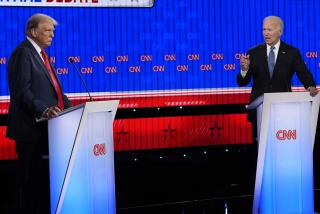Obama’s Pacific trade deal becomes a surprising political casualty of 2016 campaign

The sweeping Trans-Pacific Partnership trade pact was once seen as a rare bipartisan initiative that a Republican-led Congress and President Obama might actually be able to push through in an unruly election year.
But that was before the rollicking 2016 presidential campaign turned globalization into a potent symbol of job loss and wage stagnation.
Now the 12-nation trade pact — once hoped to be a capstone of Obama’ second term — appears all but dead as both Democrat Hillary Clinton and Republican Donald Trump promise to scrap it and negotiate a better one.
I think this is in the rear view mirror now.
— Gene Sperling, former director of the White House National Economic Council
“I think this is in the rear view mirror now,” said Gene Sperling, former director of the White House National Economic Council, at an event Wednesday sponsored by the Atlantic at the Democratic National Convention in Philadelphia.
One of the final blows came Tuesday when Virginia’s Democratic Gov. Terry McAuliffe, a longtime Clinton ally, suggested that even though Clinton had reversed her support for the pact amid heavy opposition from unions and supporters of primary rival Sen. Bernie Sanders, she might find a way to revive the TPP, if elected.
That inadvertently revived concerns among Clinton’s critics about her credibility and forced the campaign to reiterate her opposition.
“She doesn’t support TPP now; she is not going to support TPP after the election,” campaign manager Robby Mook said Wednesday. McAuliffe, too, quickly walked back his comments.
But the renewed attention to the sensitive issue gave Trump another chance to attack Clinton and ensured that if she ever tried to change her position again on the pact, the political costs would be far higher.
The Obama administration hopes an opening still exists for Congress to give final passage to the deal after the November election in a lame-duck session.
But Republicans, including House Speaker Paul D. Ryan and Senate Majority Leader Mitch McConnell — both advocates of free trade — have casts doubts about a lame-duck vote.
The turn of events has been swift and decisive, and an unlikely outcome from barely a year ago when lawmakers of both parties joined forces in an unusual partnership to open a new era of trade relations.
At the time, Republican and Democratic leaders envisioned the trade deal not only as a needed economic boost but a strategic geo-political move to gather Pacific allies away from the powerful orbit of China.
“America is back in the trade business,” McConnell said last year in an optimistic moment as the Senate advanced legislation to fast-track the eventual deal.
Republicans and their allies in the business community have traditionally promoted trade deals while Democrats, though wary, were willing this time to back Obama’s second-term priority, especially with bolstered protections for labor and the environment.
But on the presidential campaign trail, another narrative was gaining popular support.
TRAIL GUIDE: All the latest news on the 2016 presidential campaign »
Trump launched a tirade against manufacturers like Carrier and Nabisco, which had moved their operations abroad, turning trade into one of his signature issues.
Trump’s message shocked fellow Republicans. But it resonated deeply with white, working-class voters — many in former Democratic strongholds in Rust Belt states. He railed against former President Clinton’s role in passage of the North American Free Trade Agreement.
On the Democratic side, Sanders took a similarly populist attack from the left, which had already grown skeptical of NAFTA and other previous trade pacts. It left Clinton with almost no other option than to abandon the deal she had once promoted as Obama’s secretary of State.
“There’s just been a bigger political earthquake this year,” said Edward Alden, senior fellow at the Council on Foreign Relations who has studied trade issues for 25 years.
In the past, the government’s desire to pursue free trade for geopolitical reasons and the business community’s economic motivations were “always enough to overcome the other interests,” he said. “That is no longer true, and that is a big change — and leads to a whole lot of questions about what happens next.”
Negotiating a new deal is no easy task — the Pacific deal has been eight years in the making, and most observers believe all sides would essentially have to start from scratch.
Cracks of dissent had already begun to show in November, when the 12 nations formally announced their agreement. Almost immediately key Republican supporters such as Sen. Orrin Hatch (R-Utah) began to voice doubts about the final terms.
That chasm has only deepened as the campaign trail rhetoric intensified.
But Robert Scott, who has been following trade issues for years at the liberal-leaning Economic Policy Institute and opposes the deal, said the endgame remains to be determined.
“I don’t think it’s over until it’s over,” he said.
Staff writers David Lauter and Evan Halper in Philadelphia contributed to this story.
Twitter: @LisaMascaro
MORE FROM POLITICS
In a campaign that pits fear against facts, Hillary Clinton has a tough opponent in Trump
Your Essential Politics guide to Day 3 of the Democratic National Convention
More to Read
Get the L.A. Times Politics newsletter
Deeply reported insights into legislation, politics and policy from Sacramento, Washington and beyond. In your inbox three times per week.
You may occasionally receive promotional content from the Los Angeles Times.











